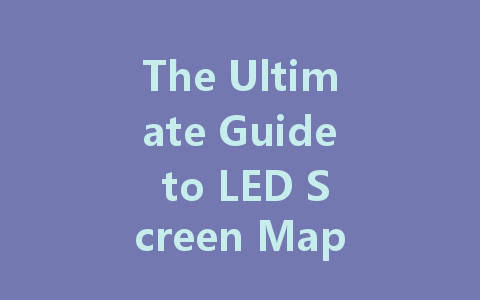
In today’s digital age, the visual experience plays an essential role in various fields such as advertising, entertainment, art, and corporate events. One of the most innovative technologies contributing to this immersive experience is LED screen mapping. This article will explore what LED screen mapping is, its primary techniques, applications, and tips for effective implementation.
What is LED Screen Mapping?
LED screen mapping, often referred to as projection mapping, is an advanced technique that allows for the projection of digital content onto irregularly shaped surfaces, creating a dynamic visual display. By using high-powered projectors or LED screens, artists and technologists can transform static objects, buildings, or screens into lively focal points that engage audiences in unique ways.
This technique provides an opportunity to combine creativity with technology, leading to stunning visual effects and interactive displays that are both informative and entertaining.
Techniques Used in LED Screen Mapping
The foundation of successful LED screen mapping lies in content creation. Whether it’s animated graphics, videos, or interactive designs, high-quality visuals are crucial. Artists often use specialized software to design and animate these visuals, ensuring they sync perfectly with the shape and contours of the surface being mapped.
Once the content is designed, the next step involves calibration. This process ensures that the projection or display aligns perfectly with the surface. Accurate calibration is essential for creating a seamless and coherent visual experience. Technicians adjust the projectors’ angles and the intensity of the light to achieve the best results.
Various software solutions are available for LED screen mapping, each offering different features and capabilities. Some popular options include MadMapper, Resolume, and TouchDesigner. These platforms allow users to map content onto surfaces, adjust settings, and synchronize visuals with audio, enhancing the overall impact of the performance.
For those looking to take their mapping to the next level, incorporating interactive elements can significantly enhance the viewer experience. By using sensors or mobile devices, audiences can influence the projections in real-time, creating an engaging environment that boosts participation and interest.
Applications of LED Screen Mapping
LED screen mapping has carved a niche for itself in various industries. Here are some notable applications:
Brands worldwide utilize LED screen mapping during product launches and advertisements to create memorable experiences for potential customers. A well-executed mapping presentation can captivate an audience, helping to forge a stronger connection with the brand.
Artists are embracing LED screen mapping as a medium for creative expression. Gallery exhibitions often feature immersive installations that transform a room or an object into a canvas for vivid storytelling through light and color.
From music festivals to theatrical performances, LED screen mapping has become a staple of live entertainment. Coordinated with music and performance elements, it adds depth and dimension, enhancing the overall atmosphere of the event.
In the corporate world, LED screen mapping is used for presentations and trade shows. Companies leverage this technology to deliver compelling content that engages stakeholders and leaves a lasting impression.
Tips for Effective LED Screen Mapping
To ensure the success of your LED screen mapping project, consider the following tips:
Before creating content, think about who will be viewing your work. Different demographics respond to various visuals, so tailor your approach accordingly.
Always run multiple tests before the final presentation. This allows you to identify and resolve any technical issues that may arise, ensuring a smoother execution.
Thoroughly planning the layout of your mapping will help optimize the viewer’s experience. Ensure the visuals fit the intended surface, and consider the angle from which the audience will view the display.
Don’t hesitate to iterate on your designs based on feedback. Engaging with test audiences can provide insights that drive improvements in your mapping content.
Conclusion
LED screen mapping is more than just a technological trend; it’s a transformative tool bridging the worlds of technology, art, and business. With its ability to create visually stunning displays, it opens up a multitude of opportunities across various sectors. By embracing the techniques and applications highlighted in this guide, you can harness the power of LED screen mapping to elevate your projects and captivate your audience. Whether you’re an artist, marketer, or event planner, this innovative approach can help you stand out in a crowded digital landscape.